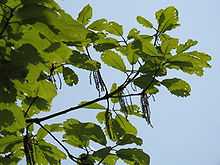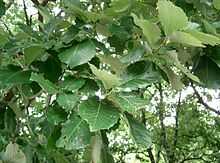Quercus aliena
| Quercus aliena | |
|---|---|
 | |
| Leaves and pollen catkins. Osaka, Japan. | |
| Scientific classification | |
| Kingdom: | Plantae |
| (unranked): | Angiosperms |
| (unranked): | Eudicots |
| (unranked): | Rosids |
| Order: | Fagales |
| Family: | Fagaceae |
| Genus: | Quercus |
| Section: | Quercus |
| Species: | Q. aliena |
| Binomial name | |
| Quercus aliena Blume [1] | |
Quercus aliena, the Oriental White Oak, is a species of oak in the family Fagaceae, in the white oak section Quercus.[2][3]
Description

It is a deciduous tree growing to 30 m tall with a trunk up to 1 m diameter with fissured grey-brown bark. The leaves are obovate to oblong, glabrous above, glabrous to densely grey-white hairy below, mostly 10–20 cm long and 5–14 cm wide (rarely up to 30 cm long and 16 cm wide), with 9 to 15 lobes on each side, and a 10–13 mm petiole.
The flowers monecious catkins. The acorns are 17–25 mm long and 13–18 mm wide, a third to a half enclosed in a green-grey cup on a short peduncle; they are solitary or 2–3 together, and mature in about six months from pollination. A long-lived tree, it is slow-growing.[4][5][6]
Distribution and taxonomy

It is native to Korea, Japan (where it occurs in Honshu, Shikoku, and Kyushu), China (where it occurs in the provinces of Anhui, Gansu, Guangdong, Guangxi, Guizhou, Hebei, Henan, Hubei, Hunan, Jiangsu, Jiangxi, Liaoning, Shaanxi, Shandong, Shanxi, Sichuan, Yunnan, and Zhejiang), and also very locally in Taiwan.[4][5]
Three to five varieties are accepted:[4][2]
- Quercus aliena var. aliena. Leaf margin wavy; leaf greyish below.
- Quercus aliena var. acutiserrata Maxim. Leaf margin serrated, with sharp serration; leaf densely hairly below with greyish hairs.
- Quercus aliena var. pekingensis Schottky. Leaf margin serrated, with rounded serration; leaf glabrous or only slightly hairy below.
- Quercus aliena var. alticupulifirmis H.Wei Jen & L.M.Wang (not accepted by Flora of China).
- Quercus aliena var. pellucida Blume (not accepted by Flora of China).
Hybrids between Quercus aliena and several other oaks in Quercus sect. Quercus are known.[2]
Common names
In China it is called ru chi, hu li, or hi li. Quercus aliena var. acutiserrata is referred to as rui chi hu li, while var. aliena is referred to as hu li. In Japan it is called Naragashiwa.[4][3]
Cultivation and uses
The wood is used in eastern Asia for boat building and wood flooring for houses. The seeds can be crushed into a powder and used as a soup thickener and for mixing into cereals and breads. The seeds when roasted can also be used as a substitute for coffee.[6] Galls produced by the larvae of insects are a rich source of tannin.[6]
Oriental White Oak was introduced to Europe in 1908, but remains rare in cultivation outside of its native area.[7] The taproot is deep, making older plants difficult to move.[6] It grows in full sun or partial shade and tolerates strong winds. It can grow in almost any type of soil as long as not waterlogged.[6]
References
| Wikimedia Commons has media related to Quercus aliena. |
- ↑ Species was originally described and published in Mus. Bot. 1(19): 298. 1851. "Plant Name Details for Quercus aliena Blume". IPNI. Retrieved July 19, 2010.
- ↑ 2.0 2.1 2.2 International Oak Society oak checklist Quercus aliena
- ↑ 3.0 3.1 USDA Germplasm Resources Information Network Quercus aliena
- ↑ 4.0 4.1 4.2 4.3 Flora of China: Quercus aliena
- ↑ 5.0 5.1 Su, Mong-Huai, et al. (2003). Rediscovery of Quercus aliena Blume (Fagaceae) in Taiwan. Taiwania 48 (2): 112-117 full text.
- ↑ 6.0 6.1 6.2 6.3 6.4 Plants for a Future Quercus aliena
- ↑ Bean, W. J. (1976). Trees and shrubs hardy in the British Isles 3: 461. 8th ed., revised. John Murray.